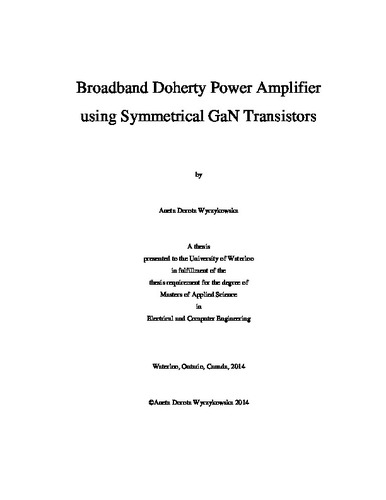| dc.contributor.author | Wyrzykowska, Aneta | |
| dc.date.accessioned | 2015-01-05 16:17:47 (GMT) | |
| dc.date.issued | 2015-01-05 | |
| dc.date.submitted | 2014 | |
| dc.identifier.uri | http://hdl.handle.net/10012/9023 | |
| dc.description.abstract | The wireless industry has seen a tremendous growth in its users over the last decade. This has led the industry to adapt a number of new standards allowing for better use of the scarce and often very fragmented frequency spectrum. [1] The new standards have brought with them the use of OFDM signaling to allow for higher data rates and better robustness against frequency selective channel interference. The OFDM protocols combined with multi-standard radios however have provided many challenges to the radio frequency, RF, industry with the largest challenge presented to the power amplifier design. The OFDM signals are well known for their high peak to average power ratio which forces the RF equipment to work at significant back-off compared to peak power. This unfortunately leads to rather low system efficiencies.
To address the problem the Doherty power amplifier has been brought back into the design community as it directly solves the issues related to average power efficiency. To date however many of the Doherty designs have focused on the narrowband application of the power amplifier often targeting a single standard with bandwidths directly tied to the operational band which at best is usually only couple hundred MHz wide. With the recent changes in the standards and the ever growing desire to provide several standards on one radio the Doherty has to be redesigned to allow for broadband communications.
This thesis examines the major sources of bandwidth limitation in the Doherty power amplifier and provides a review of the current approaches to solving the problem. It then goes on to propose several changes in the Doherty architecture to allow for the use of complex impedance to provide both higher efficiency at back-off and wider operational bandwidth.
The proposed technique was then used to design a symmetrical Doherty power amplifier targeted to operate in the 1.8 – 2.8 GHz frequency range with 42 dBm of output power and back-off efficiency above 50%. | en |
| dc.language.iso | en | en |
| dc.publisher | University of Waterloo | en |
| dc.subject | GaN Doherty broadband power amplifier | en |
| dc.subject | high efficiency power amplifier | en |
| dc.title | Broadband Doherty Power Amplifier using Symmetrical GaN Transistors | en |
| dc.type | Master Thesis | en |
| dc.pending | false | |
| dc.subject.program | Electrical and Computer Engineering | en |
| dc.description.embargoterms | 1 year | en |
| dc.date.embargountil | 2016-01-05T16:17:47Z | |
| uws-etd.degree.department | Electrical and Computer Engineering | en |
| uws-etd.degree | Master of Applied Science | en |
| uws.typeOfResource | Text | en |
| uws.peerReviewStatus | Unreviewed | en |
| uws.scholarLevel | Graduate | en |

